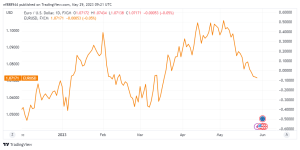The EURUSD activity is anticipated to remain muted at the start of the week.
At the start of the week, the EURUSD entered a consolidation period just over 1.0700. The pair is expected to remain sideways on Monday due to a lack of fundamental factors. And weak trading conditions in the United States due to the Memorial Day weekend.
The US Bureau of Economic Analysis said on Friday that the Core Personal Consumption Expenditures (PCE) Price Index. The Federal Reserve’s preferred indicator of inflation, increased to 4.7% year on year in December. Cleveland Fed President Loretta Mester told CNBC that the PCE inflation report highlights the poor progress on inflation. “It is critical that the Fed does not under tighten monetary policy,” Mester noted.
Following the release of the PCE statistics and Mester’s statements, the likelihood of another 25-basis point Fed rate rise in June increased to 60% from 25% only a week earlier. As a result, the US Dollar (USD) remains strong versus its rivals, limiting EURUSD’s upside for the time being.
Market investors will be keeping a close eye on Eurozone inflation data and the US jobs report for May later this week.
Technical Analysis
Although the Euro has risen above the top boundary of the descending regression channel, it has yet to break through. Clear the 20-period Simple Moving Average (SMA), which is now at 1.0750. The Fibonacci 61.8% retracement level of the most recent rally adds to that barrier.

If the EURUSD rises over 1.0750 and begins to use it as support, it might continue its rebound towards 1.0775 (50-period SMA) and 1.0800 (psychological level, Fibonacci 50% retracement).
If the EURUSD falls below 1.0720 and returns to the regression channel, it may find interim support at 1.0700 (psychological level, static level). A four-hour closure below that level may entice selling, causing the pair to tumble towards 1.0660 (the lower-limit of the declining channel).









